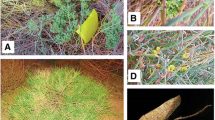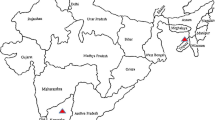Abstract
California privet (Ligustrum ovalifolium Hassk.) plants exhibiting leaf yellowing, witches’ broom, dieback and decline symptoms were observed for two years (2010–2011) in three gardens at Adana region (Turkey). DNA isolated from symptomatic and healthy plants was used to amplify 16S rDNA fragments by direct and nested-PCR. Phytoplasmas were detected in 21 symptomatic plants, out of 30 samples collected, whilst no PCR amplifications were obtained from asymptomatic plants. BLAST analysis of the 16S rDNA showed that the phytoplasma found in L. ovalifolium from Turkey, denoted as Turkish Ligustrum witches’ broom phytoplasma (TuLiWB), most closely resembled members of group 16SrII (peanut witches’ broom group) and shared up to 92 % sequence identity. Based on in silico 16S rDNA RFLP analysis and automated calculation of the pattern similarity coefficient, TuLiWB showed molecular characteristics different from all previously described phytoplasma species to represent a new taxon. Similar indication also emerged from the phylogenetic tree which allocated it in a novel discrete subclade within the phytoplasma clade. This is the first report on the presence of a phytoplasma affecting L. ovalifolium and whether this novel phytoplasma is the same agent reported as a mycoplasma-like organism (MLO) and associated with witches’ broom disease of Ligustrum in Korea (1989) is yet to be determined.



Similar content being viewed by others
References
Agamirov, U.M. (1989). Ligustrum Species in Apsheron Azerbaijan Ssr Ussr. Izvestiya Akademii Nauk Azerbaidzhanskoi SSR Seriya. Biologicheskikh Nauk: 35–41.
Ahrens, U., & Seemüller, E. (1992). Detection of DNA of plant pathogenic mycoplasmalike organisms by a polymerase chain reaction that amplifies a sequence of the 16S rRNA gene. Phytopathology, 82, 828–832.
Altschul, S. F., Stephen, F., Gish, W., Miller, W., Myers, E. W., & Lipman, D. J. (1990). Basic local alignment search tool. Journal of Molecular Biology, 215, 403–410.
Chai, J. K., & Kim, Y. H. (1989). Studies on witches’-broom of Ligustrum ovalifolium Hasskarl caused by mycoplasma-like organism (MLO). Journal of Korean Forestry and Society, 78, 103–118.
Firrao, G., Garcia-Chapa, M., & Marzachì, C. (2007). Phytoplasmas: genetics, diagnosis and relationships with the plant and insect host. Frontiers in Bioscience, 12, 1353–1375.
Gundersen, D. E., & Lee, I. M. (1996). Ultrasensitive detection of phytoplasmas by nested-PCR assays using two universal primer pairs. Phytopathologia Mediterranea, 35, 144–151.
Huche-Thelier, L., Guerin, V., & Charpentier, S. (2006). Interactions between N, P and C mobilisations during spring growth of a semi-evergreen shrub (Ligustrum ovalifolium L.) grown in containers with different fertilisation schedules. Scientia Horticulturae (Amsterdam), 107, 297–305.
IRPCM, Phytoplasma ⁄ Spiroplasma Working Team-Phytoplasma taxonomy group. (2004). “Candidatus Phytoplasma”, a taxon for the wall-less, non-helical prokaryotes that colonize plant phloem and insects. International Journal of Systematic and Evolutionary Microbiology, 54, 1243–1255.
Marcone, C., Ragozzino, A., & Seemüller, E. (1997). Detection and identification of Phytoplasmas in yellows-diseased weeds in Italy. Plant Pathology, 46, 530–537.
Mitrovıć, M., Toševski, I., Krstić, O., Cvrković, T., Krnjajić, S., & Jovıć, J. (2011). A strain of phytoplasma related to 16SrII group in Picris hieracioides L. in Serbia. Bulletin of Insectology, 64(Supplement), S241–S242.
Nicholas, K. B., Nicholas, H. B., Jr., & Deerfield, D. (1997). GeneDoc: analysis and visualization of genetic variation. EMBNEWS, 4, 14.
Perrière, G., & Gouy, M. (1996). WWW-Query: An on-line retrieval system for biological sequence banks. Biochimie, 78, 364–369.
Sawayanagi, T., Horikoshi, N., Kanehira, T., Shinohara, M., Bertaccini, A., Cousin, M. T., Hiruki, C., & Namba, S. (1999). “Candidatus phytoplasma japonicum”, a new phytoplasma taxon associated with Japanese Hydrangea phyllody. International Journal of Systematic Bacteriology, 49, 1275–1285.
Thompson, J. D., Gibson, T. J., Plewniak, F., Jeanmougin, F., & Higgins, D. G. (1997). The ClustalX windows interface: flexible strategies for multiple sequence alignment aided by quality analysis tools. Nucleic Acids Research, 24, 4876–4882.
Tolu, G., Botti, S., Garau, R., Proa, V. A., Sechi, A., Prota, U., & Bertaccini, A. (2006). Identification of a 16SrII-E phytoplasma in Calendula arvensis, Solanum nigrum, and Chenopodium spp. Plant Disease, 90, 25–330.
Wei, W., Davis, R. E., Lee, I. M., & Zhao, Y. (2007). Computer-simulated RFLP analysis of 16S rRNA genes: identification of ten new phytoplasma groups. International Journal of Systematic and Evolutionary Microbiology, 57, 1855–1867.
Wei, W., Lee, I. M., Davis, R. E., Suo, X., & Zhao, Y. (2008). Automated RFLP pattern comparison and similarity coefficient calculation for rapid delineation of new and distinct phytoplasma 16Sr subgroup lineages. International Journal of Systematic and Evolutionary Microbiology, 58, 2368–2377.
Zhao, Y., Wei, W., Lee, I. M., Shao, J., Suo, X., & Davis, R. E. (2009). Construction of an interactive online phytoplasma classification tool, iPhyClassifier, and its application in analysis of the peach X-disease phytoplasma group (16SrIII). International Journal of Systematic and Evolutionary Microbiology, 59, 2582–2593.
Zhao, Y., Wei, W., Davis, R. E., & Lee, I. M. (2010). Recent advances in 16S rRNA gene-based phytoplasma differentiation, classification and taxonomy. In P. G. Weintraub & P. Jones (Eds.), Phytoplasmas-Genomes. Plant Hosts and Vectors (pp. 1–18). Cambridge: CABI Pubbl.
Acknowledgements
We are grateful to Dr. C. Marzachì (Istituto di Virologia Vegetale [IVV], CNR, Torino, Italy) and Dr. M. Mitrovıć (Institute for Plant Protection and Environment, Department of Plant Pests, Banatska, Zemun, Serbia) for providing DNA of phytoplasma reference strains.
Author information
Authors and Affiliations
Corresponding author
Rights and permissions
About this article
Cite this article
Çağlar, B.K., Elbeaino, T. A novel phytoplasma associated with witches’ broom disease of Ligustrum ovalifolium in Turkey. Eur J Plant Pathol 137, 113–117 (2013). https://doi.org/10.1007/s10658-013-0222-7
Accepted:
Published:
Issue Date:
DOI: https://doi.org/10.1007/s10658-013-0222-7




